西方译论笔记
- 格式:doc
- 大小:360.50 KB
- 文档页数:13
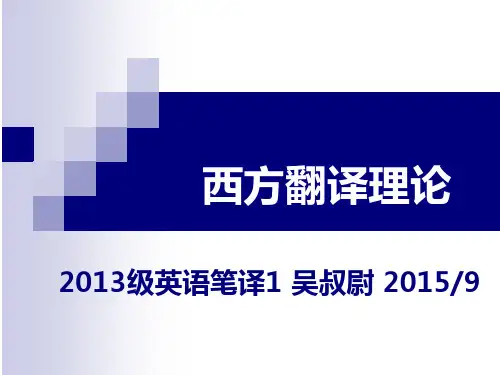
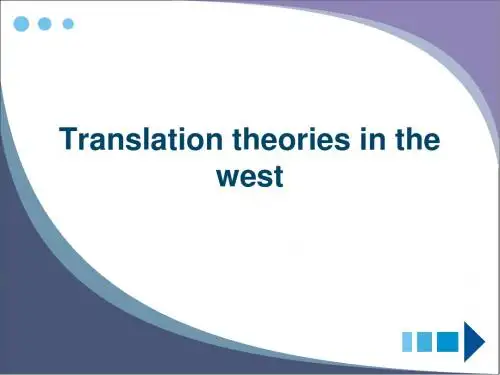

most basic structures of Chomsky’s model,for Nida,kernels are the basic structural elements out of which language builds its elaborate(详尽复杂的) surface structures[用来构成语言复杂表层结构的基本结构成分].Kernels are the level at which the message is transferred into the receptor(受体)language before being transformed into the surface structure in three stages:Literal transfer字面转移--minimal最低度~--literary书面~2)Analysis:generative-transformational grammar(转换生成语法by Chomsky)’s four types of functional classEvent(verb)事件:行动、过程等发生的事Object(noun)实体:具体的人和物Abstract(quantities and qualities,adjective)抽象概念Relational(gender,qualities,prepositions and conjunctions)关系2,Basic factors in translation1)The nature of message:content V.S.form2)The purpose(s)of the author/translatorTypes of purposes identified by Nida:①for information②suggest a behavior③imperative(祈使,命令)purpose3)The audiences(4types):children;new literates;average literate adult;specialists3,Relatedness(相关)of language&culture4,Two basic orientations(方向)in translating1)Formal Equivalence(F-E):focuses on the message itself,in both form and content.•Principles governing F-E:①grammatical units语法单元②consistency in word usage词语用法前后一致,连贯性③meanings in terms of the source context源语语境意义2)D-E(dynamic equivalence):①based on the principle of equivalent effect(•Principles governing it)②aiming at complete naturalness of expression;③unnecessary to understand the source culture.•Economic~can be transferable with cultural~.实际上三种形式均可互相转化。
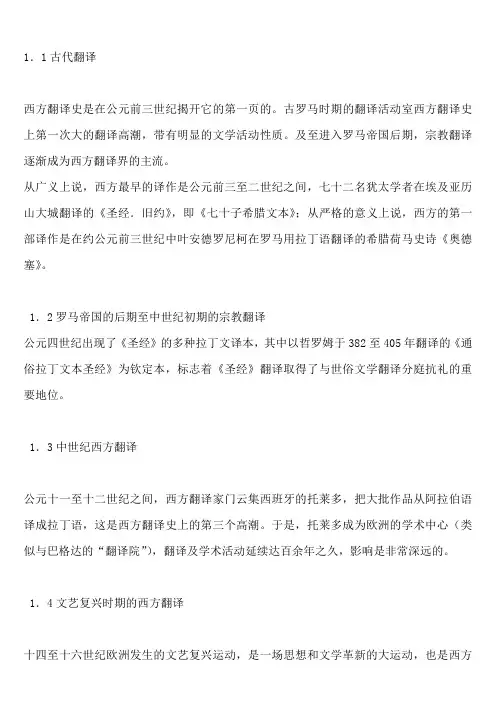
1.1古代翻译西方翻译史是在公元前三世纪揭开它的第一页的。
古罗马时期的翻译活动室西方翻译史上第一次大的翻译高潮,带有明显的文学活动性质。
及至进入罗马帝国后期,宗教翻译逐渐成为西方翻译界的主流。
从广义上说,西方最早的译作是公元前三至二世纪之间,七十二名犹太学者在埃及亚历山大城翻译的《圣经.旧约》,即《七十子希腊文本》;从严格的意义上说,西方的第一部译作是在约公元前三世纪中叶安德罗尼柯在罗马用拉丁语翻译的希腊荷马史诗《奥德塞》。
1.2罗马帝国的后期至中世纪初期的宗教翻译公元四世纪出现了《圣经》的多种拉丁文译本,其中以哲罗姆于382至405年翻译的《通俗拉丁文本圣经》为钦定本,标志着《圣经》翻译取得了与世俗文学翻译分庭抗礼的重要地位。
1.3中世纪西方翻译公元十一至十二世纪之间,西方翻译家门云集西班牙的托莱多,把大批作品从阿拉伯语译成拉丁语,这是西方翻译史上的第三个高潮。
于是,托莱多成为欧洲的学术中心(类似与巴格达的“翻译院”),翻译及学术活动延续达百余年之久,影响是非常深远的。
1.4文艺复兴时期的西方翻译十四至十六世纪欧洲发生的文艺复兴运动,是一场思想和文学革新的大运动,也是西方翻译史上的一次大发展。
特别是文艺复兴运动在西欧各国普遍展开的十六世纪及尔后一个时期,翻译活动达到了前所未见的高峰。
翻译活动深入到思想、政治、哲学、文学、宗教等各个领域,涉及大古代和当代的主要作品,产生了一大批杰出的翻译家和一系列优秀的翻译作品。
在德国,宗教改革家马丁.路德于1522至1534年翻译刊行第一部“民众的圣经”,开创了现代德语发展的新纪元。
在法国,文学阿米欧先后用了十七年(1542-1559年)时间,译出了普鲁塔克的《希腊罗马名人比较列传》(简称《名人传》),查普曼1598至1616年译的《伊利亚特》和《奥德赛》,弗罗里欧1603年所译蒙田的《散文集》,乃是英语文学译著中一群灿烂的明星。
而1611年《钦定圣经译本》的翻译出版社则标志着英国翻译史上又一次大发展。
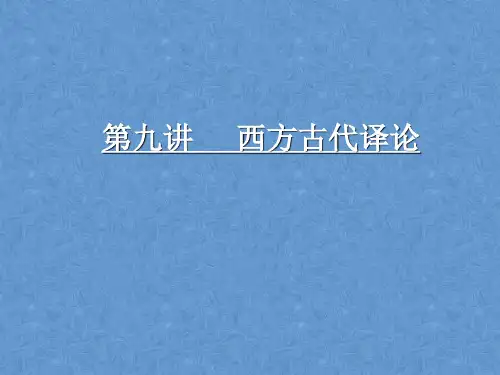
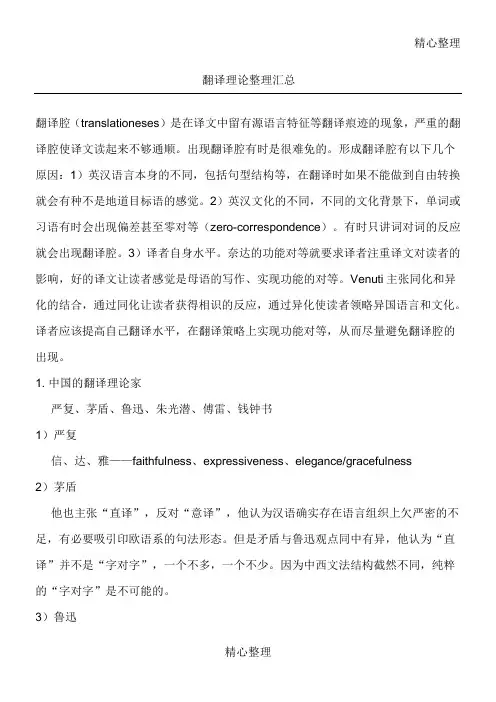
精心整理翻译理论整理汇总翻译腔(translationeses)是在译文中留有源语言特征等翻译痕迹的现象,严重的翻译腔使译文读起来不够通顺。
出现翻译腔有时是很难免的。
形成翻译腔有以下几个原因:1)英汉语言本身的不同,包括句型结构等,在翻译时如果不能做到自由转换就会有种不是地道目标语的感觉。
2)英汉文化的不同,不同的文化背景下,单词或习语有时会出现偏差甚至零对等(zero-correspondence)。
有时只讲词对词的反应就会出现翻译腔。
3)译者自身水平。
奈达的功能对等就要求译者注重译文对读者的影响,好的译文让读者感觉是母语的写作、实现功能的对等。
Venuti主张同化和异化的结合,通过同化让读者获得相识的反应,通过异化使读者领略异国语言和文化。
译者应该提高自己翻译水平,在翻译策略上实现功能对等,从而尽量避免翻译腔的出现。
1. 中国的翻译理论家严复、茅盾、鲁迅、朱光潜、傅雷、钱钟书1)严复信、达、雅——faithfulness、expressiveness、elegance/gracefulness2)茅盾他也主张“直译”,反对“意译”,他认为汉语确实存在语言组织上欠严密的不足,有必要吸引印欧语系的句法形态。
但是矛盾与鲁迅观点同中有异,他认为“直译”并不是“字对字”,一个不多,一个不少。
因为中西文法结构截然不同,纯粹的“字对字”是不可能的。
3)鲁迅鲁迅的“宁信而不顺”是“凡是翻译,必须兼顾两面,一当然是力求易解,一则保存着原作风姿”,这是鲁迅的基本思想。
针对当年那种“牛头不对马嘴”的胡译、乱译以及所谓“与其信而不顺,不如顺而不信”的说法(梁秋实),提出了“宁信而不顺”这一原则,主张直译,以照顾输入新表现法和保持原作的风貌。
他还认为,翻译一要“移情”、“益志”,译文要有“异国情调”,二要“输入新的表现法”,以改进中文的文法,在当时主要表现为改进白话文。
必须强调的是,鲁迅其实是主张翻译要通顺,又要忠实的。
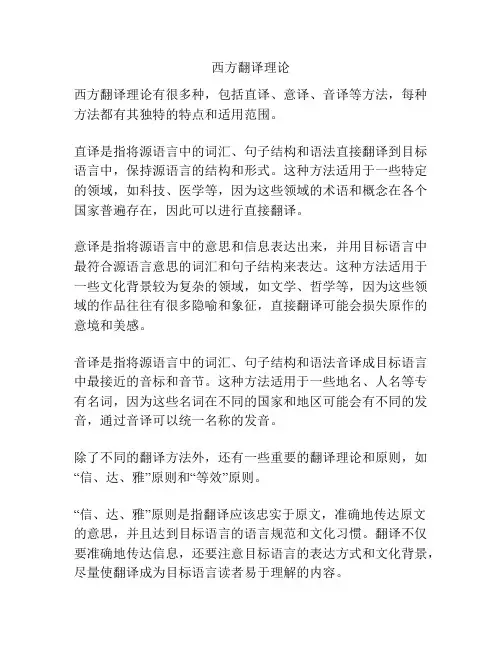
西方翻译理论西方翻译理论有很多种,包括直译、意译、音译等方法,每种方法都有其独特的特点和适用范围。
直译是指将源语言中的词汇、句子结构和语法直接翻译到目标语言中,保持源语言的结构和形式。
这种方法适用于一些特定的领域,如科技、医学等,因为这些领域的术语和概念在各个国家普遍存在,因此可以进行直接翻译。
意译是指将源语言中的意思和信息表达出来,并用目标语言中最符合源语言意思的词汇和句子结构来表达。
这种方法适用于一些文化背景较为复杂的领域,如文学、哲学等,因为这些领域的作品往往有很多隐喻和象征,直接翻译可能会损失原作的意境和美感。
音译是指将源语言中的词汇、句子结构和语法音译成目标语言中最接近的音标和音节。
这种方法适用于一些地名、人名等专有名词,因为这些名词在不同的国家和地区可能会有不同的发音,通过音译可以统一名称的发音。
除了不同的翻译方法外,还有一些重要的翻译理论和原则,如“信、达、雅”原则和“等效”原则。
“信、达、雅”原则是指翻译应该忠实于原文,准确地传达原文的意思,并且达到目标语言的语言规范和文化习惯。
翻译不仅要准确地传达信息,还要注意目标语言的表达方式和文化背景,尽量使翻译成为目标语言读者易于理解的内容。
“等效”原则是指翻译应该追求源语言和目标语言的表达效果和交际效果的一致性。
翻译不是简单地将源语言换成目标语言,而是要在保持原文意思的基础上,使翻译成为目标语言读者能够接受和理解的内容。
总的来说,西方翻译理论强调翻译的准确性、忠实性和可读性。
翻译不仅仅是一种语言转换的过程,更是一种文化交流和理解的方式。
只有深入理解源语言和目标语言的文化差异,才能做到准确地传达信息,并且使翻译成为目标语言读者能够理解和接受的内容。
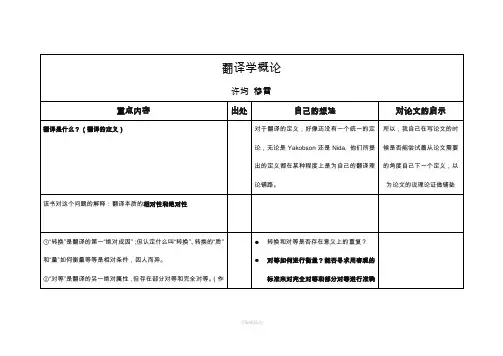
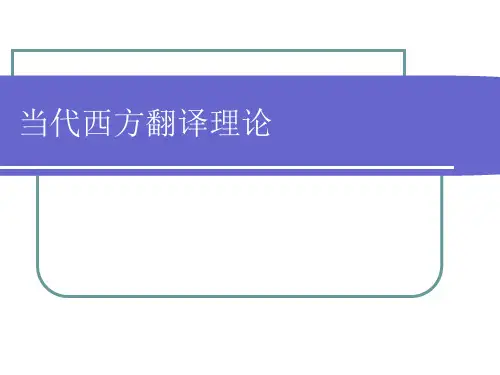
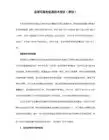
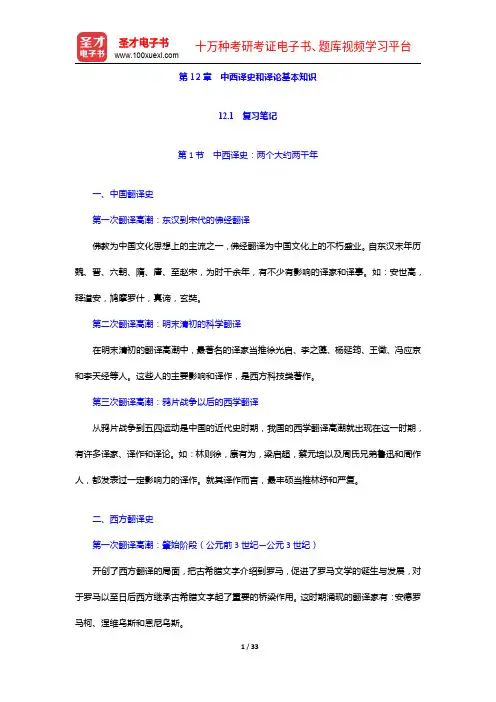
第12章中西译史和译论基本知识12.1复习笔记第1节中西译史:两个大约两千年一、中国翻译史第一次翻译高潮:东汉到宋代的佛经翻译佛教为中国文化思想上的主流之一,佛经翻译为中国文化上的不朽盛业。
自东汉末年历魏、晋、六朝、隋、唐、至赵宋,为时千余年,有不少有影响的译家和译事。
如:安世高,释道安,鸠摩罗什,真谛,玄奘。
第二次翻译高潮:明末清初的科学翻译在明末清初的翻译高潮中,最著名的译家当推徐光启、李之藻、杨延筠、王徵、冯应京和李天经等人。
这些人的主要影响和译作,是西方科技类著作。
第三次翻译高潮:鸦片战争以后的西学翻译从鸦片战争到五四运动是中国的近代史时期,我国的西学翻译高潮就出现在这一时期,有许多译家、译作和译论。
如:林则徐,康有为,梁启超,蔡元培以及周氏兄弟鲁迅和周作人,都发表过一定影响力的译作。
就其译作而言,最丰硕当推林纾和严复。
二、西方翻译史第一次翻译高潮:肇始阶段(公元前3世纪—公元3世纪)开创了西方翻译的局面,把古希腊文字介绍到罗马,促进了罗马文学的诞生与发展,对于罗马以至日后西方继承古希腊文字起了重要的桥梁作用。
这时期涌现的翻译家有:安德罗马柯、涅维乌斯和恩尼乌斯。
第二次翻译高潮:罗马帝国后期至中世纪初期(3世纪—6世纪)这一时期,宗教势力强大,《圣经》成了宗教界信奉的经典。
但《圣经》由希伯来语和希腊语写成,必须译为拉丁语才能为罗马人接受。
圣经翻译到公元4世纪达到高潮,杰罗姆于382年至405年翻译的《通俗拉丁文本圣经》标志着《圣经》翻译取得了与世俗文学分庭抗礼的重要地位。
第三次翻译高潮:中世纪后期(11世纪—12世纪)此时,西方开始了基督教徒和穆斯林的频繁接触,出现了大批阿拉伯语著作,特别是伊斯兰教作品译成拉丁语成为热潮。
阿拉伯人把从希腊带到巴格达的作品译成阿拉伯语,而众多学者在西班牙的托莱多将这些阿拉伯译本译成了拉丁语。
第四次翻译高潮:文艺复兴时期(14世纪—16世纪)文艺复兴运动从14世纪开始,到了16世纪在西欧各国普遍展开,翻译活动开始了前所未有的高峰期。
《⾼级英汉翻译理论与实践》复习笔记(彼得第14章彼得·纽马克和他的贡献⼀、纽马克翻译理论概述1. 彼得·纽马克是英国翻译教育家和理论家。
著作:《翻译教程》(A Textbook of Translation)。
2. 纽马克与奈达理论⽐较(1) 纽马克略倾向于直译,因为他崇尚真实性和准确性。
(2) 奈达认为翻译是⼀门科学,⽽纽马克认为它并不是科学。
(3) 纽马克和奈达⼀样都认为交流是翻译的⾸要任务。
3. 纽马克的理论涉及的⾯⼴,既包括翻译的基本理论,也涉及到翻译的某些具体问题,⽽且讲解通俗易懂。
4. 纽马克的理论中最重要的是他对语义翻译和交流翻译的区分(semantic/communicative translations)以及他对语篇类别的仔细区分。
⼆、语义翻译和交流翻译1. 纽马克感到直译和意译的两元模式束缚译者,所以他创⽴了⼀个多元的模式,其中有8种供选择的⽅法:在这8种⽅法中,最下⾯的两种,即语义翻译和交流翻译是核⼼。
2. SL emphasis(强调源语)左边的⼏种⽅法都是强调源语的,只是程度不同,但即便是最⾃由的语义翻译法也是强调源语的。
(1) 逐字翻译①逐字翻译指不仅保留源语的语序,⽽且也将原⽂中的词逐⼀译进译⼊语,将源语放在上⾯,将译⼊语直接写在下⾯,以便上下对照。
这种⽅法根本不顾及上下⽂等因素。
有关⽂化的词都以直译法搬到译⼊语中。
②⽬的:⽤这种⽅法揭⽰源语的结构,或对⽐源语和译⼊语间的差别,是学术研究的⼀个⼯具,没有交流的作⽤。
(2) 直译直译指将源语的语法结构转换成译⼊语中与之最接近的结构,但源语中的词仍然⼀个⼀个地译进译⼊语,不顾及上下⽂等因素。
(3) 忠实翻译①忠实翻译指在译⼊语语法结构的限制内精确地重现原⽂的上下⽂意义。
但⽂化词照搬到译⼊语中,并保留原⽂的语法和词汇的“异常”结构(abnormality)。
②⽬的:旨在试图完全忠实原⽂作者的意图和语篇结构。
一.The North American Translation Workshop(早期北美翻译学派)Development:①The North American Translation Workshop began to study the human’s brain function in the translation .②It also put forward the nature and the definition of the translation③It purposed many questions about epistemology which made a difference in the translation study and practice.④It also doubt the standard of translation evaluation.⑤The scholars in NATW subverted many traditional translation school and expressive form.⑥It believed that translation is a kind of literary criticism.While opening up new perspectives, the general approach as practiced in the North American Translation Workshop might be characterized by a theoretical naive and subjective methodologies that tend to reinforce whatever theoretical values individual translators hold.1.I. A. RichardsRichards is a critic, linguist, poet, founder of New Criticism. He is often labeled as the father of the New Criticism, largely because of the influence of his first two books of critical theory, The Principles of Literary Criticism and Practical Criticism. Richards’s initial premises remain intact: he still believed that the field consists of texts containing a primary body of experience that readers could discern; with the proper training, a consensus could be reached regarding what that experience might be.Richards’s aims were threefold: (1) to introduce a new kind of documentation into contemporary American culture; (2) to provide a new technique for individuals to discover for themselves what they think about poetry; (3) to discover new educational methods.2. Ezra PoundEzra Pound’s theory of translation focused upon the precise rendering of details, of individual words and of single or even fragmented images;Pound’s theoretical writing fall into two periods: an early imagist phase that, while departing from traditional forms of logic, still occasionally contained abstract concepts and impressions; and a second late imagist or vorticist phase that was based on words in action and luminous details;Pound's emphasis was less on the "meaning" of the translated text or even on the meaning of specific words. Instead, he emphasized the rhythm, diction, and movement of words;Pound supposes that we can have a creative translation besides literal translation and free translation.3.Frederic WillMeaning is redefined by Will as thrust or energy. Meaning is redefined by Will not as something behind the words or text, not as an essence in a traditional metaphysical sense, but as different, as thrust of energy, something which is at the same time indeterminate and groundless and universal and originary. Translation is possible both because dynamic universals constantly and continually thrust and because language is impenetrable. In translation Will seems to find a possible / impossible paradox of language which not only defines the translation process, but defines how we come to know ourselves through language.wrence VenutiAn influential scholar among those who have broadened translation studies within the social-cultural framework is Lawrence Venuti. He put forward two translation strategies: Demesticating translation and Foreignising translation.Lawrence Venuti’s contribution to translation studies are multiple: He criticizes the humanistic underpinning of much literary translation in the United States and shows how it reinforces prevailing domestic beliefs and ideologies;He Provides a new set of terms and methods for analyzing translations;He offers a set of alternative strategies he would like translators to try.二.The Science of Translation (翻译科学派)Development:North American translation workshop might be characterized by a theoretical naive and subjective;The problem is not just a contemporary phenomenon in North America, but one that has troubled translation theory historically;People practiced translation, but they were never quite sure what they were practicing. Until early sixties, linguists has been characterized by largely descriptive research in which individual grammars were detailed. Generative transformational grammar along with its legitimacy within the field of linguistics, lent credence and influence to Nida’s science of translation.1.Noam ChomskyThe phrase structure rules generate the deep structure of a sentence, which contained all the syntactic and semantic information that determine its meaning;Chomsky’s empirical evidence of language structure is not based upon living language but on sentences found only in an ideal state;He does not claim that the deep structure are universal.The form of a particular language does not necessarily equal the form of another.2.NidaHe proposed formal equivalence and dynamic equivalence;He tries to lay the ground work for a larger audience;Nida simplifies Chomsky’s transformation-generative grammar and adopt only thelater two part of the model in order to validate his science.3.Wolfram WilssWilss’s science of translation is divided into three related but separate branches of research: (1) a description of a “general science”of translation which involves translation theory. (2) “descriptive studies”of translation relating empirical phenomenon of translation equivalence; (3) “applied research” in translation point out particular translation difficulties and ways of solving specific problems.Wilss’s argument is based less on scientific argument and more on intuition.Wilss’s work has evolved over the course of the past two decades,especially his descriptive studies, which works with pair-bound cases and explores the various possibilities for their translation.4.Functionalist theories in German language countries:Katharina Reiss; Hans Vermeer; Christiane Nord三.The Early Translation Studies(早期翻译学派)Development: P77(包括挑战、特点、目标、研究方法、影响)1.James Holmes:(如果全面解释的话,就找书91页)or (如果只是简要概括,就可以直接从91页开始找点)2.Raymond Van den Broeck: Who addressed the problem of equivalence in translation from the perspective of translation studies.3.AndréLefevere :Rewriting-Translation is a rewriting of an original text. All rewritings, whatever their intention, reflect a certain ideology and a poetics and as such manipulate literature to function in a given society in a given way.Rewriting is manipulation, undertaken in the service of power, and in its positive aspect can help in the evolution of a literature and a society. Rewritings can introduce new concepts, new genres, new devices. But rewriting can also repress innovation, distort and contain.4.JiříLevý: Levy’s theory also reinforced a by product of Formalism: in addition to the awareness of the correspondence of sign to object, there is the necessary opposite function simultaneously in process, namely that the relationship between sign and object is always inadequate.5.BassnettBassnett divides Translation Studies into four categories:History of translation;Translation in the TLcultureTranslation and linguisticsTranslation and poetic四.Polysystem Theory(多元系统学派)Development:With the incorporation of the historical horizon, polysystem theorists changed the perspective that had governed traditional translation theory and began to address a whole new series of questions. Not only are translations and interliterary connections between cultures more adequately described, but intraliterary relations within the structure of a given cultural system and actual literary and linguistic evolution are also made visible by means of the study of translated texts.1.Turij Tynjanov :According to him, any new literary work must necessarily deconstruct existing unities, or by definition it ceases to be literary.Two changes in Tynjaov’s thinking became apparent: first, “literariness” could not be defined outside of history.And second, formal unities receded in importance as the systemic laws were elevated.Tynjaov’s major contribution to literary theory was to extend, in a logical fashion, the parameters of formalism to include literary and norms.2.Itamar Even-Zohar:Even-Zohar adopted Tynjanov’s concept of system. He developed the polysystem hypothesis while working on a model for Israeli Hebrew literature. In a serious of papers written from 1970 and 1977 and collect in 1978 as “Papers in Historical Poetics” He first introduced the term “polysystem” to refer to the entire network of correlated system within society. Thus, it is a global term covering all of the literary system both major and minor existing in a given culture.He developed an approach called polysystem theory to attempt to the function of all kinds of writing within a given culture from the central canonical texts to the most marginal non-canonical texts.3.Gideon Toury:He believes that descriptive study is very important, and he distinguishes three kinds of translation norms: preliminary, initial and operational norms.Several aspects of Toury’s theory have contributed to development withing the field:(1) the abandonment of one-to-one notions of correspondence as well as the possibility off literary/linguistic equivalence (2) the involvement of literary tendencies within the target culture system in the production of any translated text.(3) the destabilization of the notion of an original message with a fixed identity;(4) the integration of both the original text and the translated text in the semiotic web of interesting cultural systems.五.Deconstruction (解构主义学派)Development:The development of translation school is deeply influenced by the trend of the times.In the mid-1960s, the theoretical circles in the West made a rebellion against structuralism and the deconstruction emerged. It also called post structuralism. From the late 1980s to the early 1990s, the influence of this trend of thought has expand gradually and has a huge impact on the traditional translation theory. Deconstructionists analyze the differences, slips, changes, and elisions that are part of every text.Deconstruction is a literary theory and philosophy of language derived principally from Jacques Derrida's 1967 work Of Grammatology. The premise of deconstruction is that all of Western literature and philosophy implicitly relies on metaphysics of presence, where intrinsic meaning is accessible by virtue of pure presence. Deconstruction denies the possibility of a pure presence and thus of essential or intrinsic meaning.1.FoucaultFoucault attempts to break down the traditional notion of the author,and instead suggests we think in terms of “author-function”Foucault thinks of the author as a series of subjective positions determined not by any single harmony of effects but by gaps, discontinuities and breakages.2.HeideggerHis thought turns more and more to language as he essay unfolds, and he continually raises the question of being. Only to see any resemblance of an answer simultaneously disappear as he comes closer to coherently structuring the question.Heidegger’s translation theory marks a significant shift, for he is not uncovering any author’s original intention, bur recovering a property of language itself.3.Jacques DerridaDerrida’s main theoretical point seems to be that there is no pour meaning, no thing to be presented, behind language, nothing to be represented.Derrida prefers the term “regulated transformation” over that translation, for he argues we will never have the transport of pure signified from one language to another. Derrida’s deconstructive theory rises in the middle of last century. It opens a “post- philosophy” era and it applied to the study of translation.Through its discussion of the Nature of language and the concern of words, he introduces key items like “Différance” and “play of trace”.。
翻译史知识点翻译史知识点:苏珊·巴斯内特和安德烈·勒费弗尔为代表的翻译文化研究学派将翻译研究转向客观描写和个案研究,把翻译放置于文本之外的、广阔的文化环境中。
操纵、改写、折射等成为文化学派的基本术语意识形态、诗学、赞助人成为改写的基本条件西方20世纪80年代称翻译学为“Translatology”或“Traduetology”霍姆斯认为翻译学应该分为纯翻译学(理论翻译学、描述翻译学)和应用翻译学许渊冲提出意美、音美、形美三美论;浅化等化深化三化论;知之好之乐之三之论罗新璋的《翻译论集》归纳出“案本——求信——神似——化境”的发展线索黄龙的《翻译得艺术教程》是我国第一部以翻译学命名的专著董秋斯在《论翻译理论的建设》一文中指出:“.......我们要完成两件具体的工作,写成这样两部大书;一,中国翻译史,二、中国翻译学”西方翻译史六次高潮1.拉丁文翻译肇始时期(公元前4世纪——公元4世纪):古希腊文学2.宗教文本翻译时期(公元5世纪——11世纪):《圣经》;杰罗姆于公元405年翻译刊行《通俗本圣经》标志着西方翻译达到了前所未有的水平3.阿拉伯百年翻译运动时期(9世纪——11世纪):希腊典籍文本;西班牙托莱多成为欧洲学术中心4.文艺复兴翻译时期(14-16世纪):马丁路德《民众的圣经》开创现代德语发展新纪元;查普曼翻译《伊利亚特》和《奥德赛》;《钦定本圣经》标志现代英语的形成,赢得了“英语中最伟大的译著”的盛誉5.17世纪至19世纪的西方翻译时期6.20世纪翻译时期翻译理论1.科勒:应用翻译理论;特殊翻译理论;一般性翻译理论2.苏珊·巴斯内特和安德烈·勒费弗尔提出从古代译论到现代译论,等值概念是其核心所在;杰罗姆模式、贺拉斯模式、施莱尔马赫模式是典型3.杰罗姆:对于宗教文本的翻译,要采用直译,但直译不是死译,要灵活处理各种语言表达习惯4.贺拉斯:译者只需忠实于客户,而不必忠实于原文;坚持意译5.施莱尔马赫:异化翻译法和归化翻译法;倾向于异化法乔治·斯坦纳:1.古罗马西塞罗、贺拉斯到18世纪英国的泰勒斯发表《论翻译的原则》(译作应该完全复述原作的思想;风格和表达方式应该与原文在特点上保持一致;与原作一样通顺流畅)2.1946 拉尔博发表《圣杰罗姆的主祷文》3.20世纪50年代4.20世纪60年代尤金·奈达和简·德·沃德《从一种语言到另一种语言》1.语文学派2. 语言学派3. 语言交际理论学派4. 社会符号学派埃德温·根茨勒《当代翻译理论》:1.美国翻译培训派2.翻译科学派3.早期翻译研究派4.多元体系派5.解构主义派陈善伟《翻译工作者手册》1.文艺学派2.音译3.语意翻译4.语用翻译5.语段翻译6.动态等值翻译7.诠释性的翻译张南峰、陈德鸿《西方翻译理论精选》1.诗人和翻译(翻译场学派)2.哲学和语言学派3.功能主义学派4.描写翻译学派5.后结构主义和后现代翻译观6.翻译研究中的文化转向李文革《西方翻译理论流派研究》翻译理论:语言学阶段,结构主义阶段,解构主义阶段类型:1.翻译的文艺学派;2.语言学派;3.翻译研究学派;4.翻译阐释学派;5.翻译的解构主义学派;6.美国翻译培训班学派7.法国释意理论派曼迪《翻译研究入门》1.等值和等效理论2.翻译转换方法3.翻译的功能理论学派4.话语及语域分析方法5.系统理论6.文化研究的类型7.异化翻译:翻译的隐身8.翻译的哲学理论9.跨学科的翻译研究翻译标准严复:信达雅泰勒斯:译作应该完全复述原作的思想;风格和表达方式应该与原文在特点上保持一致;与原作一样通顺流畅许渊冲:意美(第一位);音美(第二位);形美(第三位)庞德:形文、声文、情文翻译分类罗曼·雅各布逊:语内翻译、语际翻译、语符翻译传统的翻译研究分为1.翻译技巧与翻译艺术范畴2.翻译理论范畴3.翻译史。
Introducing Translation Studies: Theories and applicationsChapter 1 Main issues of translation studies1.1 The concept1)Translation can refer to the general subject, the product or the act of translating. It involves changing an original written text in original language intoa written text in target language.2)Czech structuralist Roman Jakobson’s categories:A.intra-lingual translation, or rewording: an interpretation of verbal signs by means of other signs of the same language;B.inter-lingual translation, translation proper: an interpretation of signs by means of some other language";C.Inter-semiotic translation,transmutation: by means of signs of non-verbal sign systems.3)Intralingua translation occurs when rephrase, explain or clarify. Intersemiotic translation occurs if a text were translated into music, film or painting.1.2 Translation studies?○1Throughout history, translations have played a crucial role in inter-human communication, providing access to important texts of academic and religious value. ○2Yet translation as an academic subject begun only fifty years ago, the Dutch-based US scholar James S. Holmes in 1972 describes the then nascent discipline as being concerned with the problems clustered round the translating and translations. ○31988, Marx Snell-Hornbs wrote that the breathtaking development and prolific international discussions call for translation studies as an independent discipline. ○4Mona Baker says the exciting new discipline bringing together scholars from a wide variety of traditional disciplines. Now, the discipline continues to develop from strength to strength.There are two very visible ways in which translation has become more prominent.1)The proliferation of translating and interpreting courses. In 1999/2000, there were at least 20 postgraduate translation courses in the UK and several Centers of Translation, at least 250universities in over 60 countries offering commercial translation courses, and still other courses, in smaller numbers, focus on literary translation.2)The 1990s also saw numerous conferences, books and journals on translation in many languages. Long-standing international journals such as Babel, Meta have been joined by, Literature inTranslation, The Translator, Perspectives (France), as well as a whole host of comparative literature. John Benjamins, Routledge and St Jerome published a number of books. In addition, there are professional publications include Interpreting and In Other Words. Other smaller periodicals give details of forthcoming events, International translation conferences were held in many countries.Translation and training translators (Bratislava, Slovakia);Literary translation (Mons, Belgium);Legal translation (Geneva, Switzerland);Gender and translation (Norwich, UK);Translation and meaning (Maastricht, the Netherlands);Research models in translation studies (UMIST,Manchester, UK);Translation as/at the crossroads of culture (Lisbon,Portugal);Translation and globalization (Tangiers, Morocco);The history of translation (Leon, Spain);Trans-adaptation and pedagogical challenges (Turku,Finland):Translation-focused comparative literature (Pretoria,South Africa and Salvador, Brazil).The abundance of translation activities indicates that it has now become one of the most active and dynamic new areas of research.1.3 A brief history1)Writings on translating go far back in history, for example, Cicero, Horace have exerted important influences. St Jerome’s approach would affect laterScriptures translations, which was the battle- ground of conflicting ideologies for over1000 years.2)Although translating practice is long established, the study was not an academic discipline until the 2nd half of 20th century. Before that,grammar-translation method had dominated secondary schools which centered on the rote of grammatical rules of the foreign language. The gearing of translation to language teaching partly explain why academia considered it to be of secondary status. Study of translated works was generally frowned upon once a student mastered skills to read the original.3)USA promoted translation in 1960s. Based on I. A. Richardss reading and creative writing workshops, translation workshops were established in Iowaand Princeton, intended as a platform for introduction and discussion of finer translation principles. Parallel to this approach was comparative literature, necessitating translation.4)Contrastive analysis attempts to identify differences between languages, although useful, seldom incorporate sociocultural and pragmatic factors.5)In 1950s and 1960s. A number of linguistic studies of translation not only demonstrated their gut link with translation, but also began to mark out theterritory of translation. Nida used the word science.1.4 The Holmes/Toury map1)Holmes’s paper the name and nature of translation studies is the founding statement. He noticed that translation research was dispersed. He stressesthe need to forge channels, cutting across disciplinary gaps to reach all scholars working in the field. He puts forward an overall framework, and has subsequently been presented by Israeli Gideon Toury.2)General theories should seek to describe or account for every type of translation and to make generalizations for all.3)Descriptive translation studies: examination of (l) the product, (2) function and (3) the process:A.Product-oriented DTS examines existing translations. E.g. an analysis of a single ST-TT pair or a comparative analysis of several TTs of thesame ST. smaller-scale studies look at a specific period, language or text type. Larger-scale can be either diachronic or synchronic.B.Function-oriented DTS, cultural oriented translation studies, a study of contexts rather than texts. E.g. which books were translated when andwhere, and what influences.C.Process-oriented DTS: the psychology of translation, i.e. it is concerned with what happens in the mind of a translator. Some later researcheswork on think-aloud protocol.4)Partial theories: restricted according to the parameters discussed below.A.Medium-restricted theories: machine translation and human translation, whether the machine/computer is working alone or as an aid to humantranslators, written or spoken, whether spoken translation (interpreting) is consecutive or simultaneous.B.Area-restricted theories are restricted to specific languages or groups of languages and/or cultures.C.Rank-restricted theories are restricted to a specific level of (normally) the word or sentence, or text.D.Text-type restricted theories look at discourse types or genres; e.g. literary, business and technical translation.E.Time-restricted theories.F.Problem-restricted theories, specific problems such as equivalence, universals of translated language.5)The applied branch of Holmess framework concerns:A.Translator training: teaching methods, testing techniques, curriculum design;B.Translation aids: dictionaries, grammars and information technology;C.Translation criticism: evaluation, the marking of student translations and the reviews of published translations.D.Translation policy: the place of translation in society, i in the language teaching and learning curriculum.6)Theoretical, descriptive and applied areas do influence one another.7)The main merit: allow a clarification and a division of labor between various areas, yet flexible enough to incorporate recent advances.8)Translation policy would nowadays far more likely be related to the ideology. The different restrictions, might well include a discourse type.Additionally, Holmes’s map omits any mention of individual style, decision-making processes.1.5Developments since 1970sContrastive analysis fell by the wayside, the concept of equivalence also declined. The linguistic-oriented science of translation continued strongly in Germany, then text types and text purpose flourished, after which the Hallidayan influence has been prominent; Then comes the descriptive approach. Even-Zohar and Gideon Toury pursued the idea of the literary polysystem; Hermans founded the Manipulation School; The dynamic, culturally oriented approach held sway for much of the following decade; Then 1990s saw n Canadian-based gender translation by Sherry Simon, the Brazilian cannibalist school by Else Vieira, postcolonial translation theory by Bengali scholars Tejaswini Niranjana and Spivak and, the cultural -oriented analysis of Lawrence Venuti.For years, translation was considered to be derivative. Now it is making swift advances worldwide, though still denied parity with other researches.Chapter 2 Translation theory before the 20th century1.Word-for-word or sense-for-sense?1)The central recurring theme of word-for-word and sense-for-sense translation is a dominating debate. Translation theory is locked in a sterile debateover literal, free and faithful translation (George Steiner). Such debate goes back to Cicero (1st century BC) and St Jerome (late 4th century CE).2)Cicero outlined his approach to translation of the speeches of the Attic oratorsI did not translate as an interpreter but as an orator, keeping the same ideas and forms, in language which conforms to our usage. And in so doing, Idid not hold it necessary to render word for word, but I preserved the general style and force of the language. an orator tried to move the listeners.3)Horace underlines the goal of producing an aesthetically pleasing and creative text in the TL.4)St Jerome, the most famous of all, in a letter addressed to a senator, defending himself:In translating from the Greek - I render not word-for-word, but sense-for- sense, except in the case of the Holy Scripture, where even the syntax contains a mysteryTo illustrate the TL taking over the sense of the ST, he uses a military image of the original text marched into the TL like a prisoner by its conqueror. 2.Martin Luther1)Issues of free and literal translation were bound up with religious and philosophical texts for over 1000 years.2)Any translation diverging from the accepted was likely to be deemed heretical. The French humanist Etienne Dolet was burned at the stake for addingthe phrase rien du tout.3)Later, non-literal translation was used as a weapon against Church. E.g. Luther infused the Bible translation with the language of ordinary people.You must ask the mother at home, the children in the street, the man in the market and look at their mouths, how they speak, and translatethat way; then they’ll understand and see that you’re speaking to them in German.4)He rejects word-for-word translation since it would be sometimes be incomprehensible.3.Faithfulness, spirit and truth1)Flora Amos sees the history of the translation theory was generally unconnected;e.g. many prefaces and comments often ignored most of what had been written before:2)Early translators often differed in terms such as faithfulness, accuracy and even the word translation itself.3)Kelly traces the history of fidelity, spirit and truth. Fidelity had initially been dismissed as literal translation by Horace. At the end of 17 century, itbecame semantic faithfulness. The Latin word spiritus denotes creative energy or inspiration, but St Augustine used it to mean Holy Spirit, and St Jerome employed it in both senses. For St Augustine, spirit, truth and content are a continuum; for St Jerome, truth meant the authentic Hebrew text. It was not until the 20 century that truth was fully equated with content.4.Early attempts at translation theory: Dryden, Dolet and Tytler1)Cowley deplores the inevitable loss of beauty in poetry translation, suggests using wit or invention to create new beauty and reproduce the spirit.Cowley even proposes imitation for this.2)For Amos (1920), the England of the 17 century marked an important step forward in translation theory with reasoned statements.3)John Dryden reduces all translation to three Categories: (author-oriented description) IMPA.Metaphrase: word by word and line by line;B.Paraphrase: translate with latitude, while keep the author in view, follow his sense closely;C.Imitation: forsake both words and sense, more or less adaptation.D.Dryden criticizes Ben Johnson as a verbal copier: "Tis much like dancing on ropes with fettered legs.E.He also rejects imitation, where the translator supposes what author would have done in our age and our country. It allows the translator tobecome more visible, but does the greatest wrong to the reputation of the dead.5)Etienne Dolet set out five principles in order of importance: AAAUKa)Understand the sense and material of the original author.b)Knowledge of both SL and TL, so as not to lessen the majesty of the language.c)Avoid word-for-word renderings.d)Avoid Latinate and unusual forms.e)Avoid clumsiness, liaise words eloquently.6)Alexander Fraser Tilter s Essay on the principles of translation (1797) is TL-reader-oriented: idea, style, easeA.The merit of the original is so completely transfused as to be distinctly felt,as it is by those who speak the language of the original.B. A complete transcript of the ideas of the original.C.The style and manner.The first two laws are the poles of faithfulness of content and form.D.Have all the ease of the original composition.E.Tytler ranks his three laws in order of importance. The discussion of translation loss and gain is in some ways presaged by him. 5.Schleiermacher and the valorization of the foreign: issues of translatability or untranslatability.1)Friedrich Schleiermacher, the German theologian: ST meaning is couched in culture-bound language and to which the TL can never fully correspond.2)In 1813, he wrote On the different methods of translating, adopted a romantic approach based on inner feeling and understanding.3)Two types of translator:A.the interpreter, who translates commercial texts;B.the translator, works on scholarly artistic texts. (On a higher creative plane, breathing new life)4)There are only two paths open to bring ST writer and TT reader together. He preferred moving reader towards writer, giving the same impression.Either the translator leaves the writer alone and moves the reader toward the writer, or he leaves the reader alone as much as possible and moves the writer toward the reader. (Schleiermacher 1813/1992: 41-2)To achieve this, the translator must adopt an alienating method, valorize the foreign.a)to seek to communicate the same impression, the level of education and understanding of the TT readers also influence;b) a language of translation may be necessary,compensating here with an imaginative word while elsewhere make do with a hackneyed expression.5)His consideration of different text types, alienating and naturalizing opposites, vision of a language of translation, hermeneutics. 6.Translation theory of the 19 and early 20 centuries in BritainIn Britain, that period focused on the status of the ST and the form of the TL. Matthew Arnold in his lecture On Translating Homer, advocated a transparent translation method. Arnold advises his audience to put their faith in scholars, who are the only ones qualified to compare the effect. Such an élitist attitude led both to the devaluation of translation (TT could never reach the heights of an ST and preferable to read the original work) and to the marginalization of translation.7.Towards contemporary translation theoryGeorge Steiner: very small range of theoretical ideas covered in this period:We have seen how translation theory pivots monotonously around undefined alternatives: letter or spirit, word or sense.Chapter 3 Equivalence and equivalent effect1 Roman Jakobson: the nature of linguistic meaning and equivalence1)American structuralist Roman Jakobson follows Saussure. The signifier and signified form the linguistic sign, but that sign is arbitrary or unmotivated.2)Translation involves substituting messages in one language for entire messages in some other language, i.e. two-equivalent messages in two different codes.Since two different sign systems partition reality differently, there is ordinarily no full equivalence. Thus, equivalence focuses on structure and terminology differences rather than inability of one to render a message in another.Examples: gender,aspect: in Russian, the verb morphology varies according to whether the action has been completed or not; semantic fields, e.g. uncle 3)Only poetry - where form expresses sense, where phonemic similarity is sensed as semantic relationship - is untranslatable2 Nida and the science of translating1)Nida attempts to move translation into a more scientific era. He borrows from semantics, pragmatics and generative-transformational grammar.2) A word acquires meaning through its context and produce varying responses with different cultures. Context is especially important when dealing withmetaphorical meaning and cultural idioms, where the sense often diverges from the sum of the individual elements.3)There are linguistic,referential (the denotative dictionary meaning) and emotive (or connotative) meaning.4)In determining the meaning, hierarchical structuring, componential analysis and Semantic structure analysis are used.5)Chomsky’s generative-transformational model analyzes sentences into a series of related levels governed by rules:A.Structure relations are universal feature of human language.B.Phrase-structure rules generate a deep structure, Transformed by TG, relating one deep structure to another (e.g. active to passive), to produceC. A final surface structure, which itself is subject to phonological and morphemic rules.D.The most basic sentences are kernel sentences, simple, active, declarative that require minimum transformation.a)Kernel is the basic structural elements out of which language builds its elaborate surface structures.b)All languages agree easier on the level of kernels than on surface.E.The surface structure of the ST is analyzed into the basic elements of the deep structure; then transferred and restructured semantically andstylistically into TT surface structure (analysis, transfer and restructuring).pared to attempts to draw up a fully comprehensive list of equivalences.6)Formal and dynamic equivalence and equivalent effect, correspondence in meaning must have priority over style.A.Formal equivalence: Focuses on message in both form and content. ST structure determines accuracy and correctness. E.g. gloss translations.B.Dynamic equivalence: based on effect, which of TL should be the same as that in SL,a graded concept.a)The message has to be tailored to the receptor’s needs and cultural expectation and aims at the closest natural equivalent.b)Adaptations of grammar, lexicon and cultural references is essential to achieve naturalness.C.The success of the translation depends on achieving equivalent response.a)Making sense; conveying the spirit and manner of the originalb)natural and easy;7)Discussion of Nida’s workA.It inevitably entails subjective judgment from the translator or analyst. His equivalence is overly described at the word levelB.Nida pointed a road away from word-for word equivalence. His model introduced a receptor-based orientation.C.Van den Broeck and Larose consider equivalent effect to be impossible (how to measure and on whom?). Qian Hu demonstrated theimpossibility of achieving equivalent effect when meaning is bound up in form. Nida is aware of the artistic sensitivity which is anindispensable ingredient in any first-rate translation.D.It remains debatable whether a translator follows these procedures in practice.E.Gentzler denigrates Nidas work for its theological and proselytizing standpoint.F.However, Nida achieved what few of his predecessors attempted: he factored into the translation equation the receivers of TT and theircultural expectations.3 Newmark: semantic and communicative translation(Newmark 1981)1)Equivalent effect is illusory and loyalty conflict will always remain as the overriding problem.2)He also raises questions concerning dynamic equivalence, asking if they are to be handed everything on a plate, with everything explained for them.3)Newmark suggests narrowing the gap with semantic and communicative translation:municative translation: equivalent effect, inoperant if the text is out of TL space and time, e.g. HomerB.Semantic translation: render as closely as the semantic and syntactic structures of SL allow, the exact contextual meaning of the original.C.Semantic translation differs from literal translation in that it respects contextD.Provided that equivalent effect is secured, the literal word-for-word translation is the best, only valid method.E.If there is a conflict between the two forms of translation, namely if semantic translation would result in an abnormal TT or would not secureequivalent effect, then communicative translation should win out.4)A.Denotative equivalence: content invariance.B.Stylistic equivalence: the lexical choices,especially between near-synonyms.C.Text-normative equivalence is related to t ext types.municative equivalence, is oriented towards the receiver of the text or message.E.A.Mona Baker, in In Other Words, equivalence is influenced by a variety of linguistic and cultural factors and is therefore always relative.B.Kenny: equivalence is supposed to define translation, and translation, in turn, defines equivalence.Chapter 4 The translation shift approach1 Vinay and Darbelnets model (2000)1)Direct translation:a)Borrowing: The SL word is transferred directly to the TL to fill a semantic gap.b)Caique: the SL expression or structure is transferred in a literal translation.仿造c)Literal translation: word-for-word translation, the most common between languages of the same family and culture.只有下列情况例外,(a) gives a different meaning or no meaning; (b) Impossible for structural reasons; (c) not have a corresponding expression within the metalinguistic experience of the TL; (d) corresponds to something at a different level of language.2)Oblique translation.In cases where not possible, the strategy of oblique translation must be use d. This covers a further four procedures:a)Transposition: a change of one part of speech for another without changing the sense, probably the most common structural change.b)Modulation调节: changes the semantics and point of view of the SL:A.Obligatory: e,g. the time when--- le moment où [lit. the moment where];B.Optional, linked to preferred structures of the two languages:e.g. it is not difficult to show , il est facile de démontrer [lit. it is easy to show].C.Modulation is the touchstone of a good translator, whereas transposition simply shows a very good command of the target language.Modulation at the level of message is subdivided along the following lines: 抽象具体、因果、局部整体、局部替换,倒置,否定,主被动转换、时空Change of symbol (including fixed and new metaphors).c)Equivalence等值: Cases where languages describe the same situation by different stylistic or structural means, particularly useful in translatingidioms and proverbs (the sense, not the image, of comme un chien dans un jeu de quilles [lit. like a dog in a set of skittles] can be rendered as like a bull in a china shop).d)Adaptation改编: Changing the cultural reference when a situation in the source culture does not exist in the target culture. For example, thegame of cricket might be best translated into French by a reference to the Tour de France.3)These operate on three levels:a)the lexicon; connectors, discourse markers, deixis and punctuationb)syntactic structures; word order and thematic structurec)the message:The utterance and its metalinguistic situation or context.4) A further important parameter is that of servitude and option:A.Servitude: obligatory transpositions and modulations for difference between language systems;B.Option: non-obligatory changes for style and preferences.C.It is option, the stylistic realm that should be the translator’s main concern. Translator should choose among the available options toexpress the nuances of the message. Five steps for options:a)Identify the translation units.b)Evaluating the descriptive, affective and intellectual content of the units.c)Reconstruct the metalinguistic context of the message.d)Evaluate the stylistic effects.e)Produce and revise the TT.The authors reject the individual word to favor units. Translation units are combination of lexicological unit and unit of thought: the smallest utterance segment whose signs are linked in such a way that they should not be translated individually.To facilitate analysis where oblique translation is used, Vinay and Darbelnet suggest numbering the translation units in both the ST and IT. The units can then be compared to see which translation procedure has been adopted.2 Catford and translation shifts1)Catford follows Firthian and Hallidayan model, analyzes language as communication, operating functionally in context and different levels and ranks2) A formal correspondent: a system-based concept. Any TL category occupy the same place of TL as the given SL category occupies in SL.3) A textual equivalent: any TL text (portion of text) equivalent to a given SL text, tied to a particular ST-TT pair4)Translation shifts are departures from formal correspondence in translation.a) A level shift: expressed by grammar in one language and lexis in anotherb)category shifts:A.Structural shifts: The most common, mostly a shift in grammatical structure.B.Class shifts: These comprise shifts from one part of speech to another. a medical student.词类转换C.Unit or rank shifts: the equivalent TL is at a different rank. 级阶转换D.Intra-system shifts: SL and TL possess similar systems but involves a non-corresponding term.E.g. advice5)His analysis of intra-system shifts was later heavily criticized for its static comparative linguistic approach. Henry considers it to be of historicalacademic interest only. ○1Equivalence depends on communicative features rather than just linguistic criteria. ○2deciding what is functionally relevant is a matter of opinion. ○3His examples are almost all idealized and decontextualized. ○4He never looks above the sentence level.3 Czech writing on translation shifts(60年代)1)○1Levý sees literary translation as both reproductive and creative, with the goal of equivalent aesthetic effect. ○2Denotative meaning, connotationstylistic arrangement, syntax, sound repetition (rhythm, etc.), vowel length and articulation should be factored into equivalence and their importance depends on text type. ○3He also looks to game theory for inspiration. ○4real-world translation is pragmatic: MINIMAX STRATEGY: The translator resolves for that one which promises a maximum of effect with a minimum of effort.2)František Miko maintains that retaining the expressive style of ST is the main goal of translator. He suggests an analysis under categories such asoperativity, iconicity, subjectivity, affectation, prominence and contrast. An analysis of expression shifts, applied to all levels, will bring to light the general system of the translation, with its dominant and subordinate elements.3)Popovičrelates shifts to literal vs. free debate, they arise from the tension between original text and translation ideal. The entry adequacy issynonymous with both faithfulness to the original stylistic equivalence. The latter is functional equivalence aiming at identical meaning.4 Van Leuven-Zwarts comparative-descriptive model of translation shifts1)Kitty van Leuven-Zwart of Amsterdam draws on Vinay and Darbelnet and Lev, attempting to systematize comparison and build a discourseframework for fictional texts above sentence level.2)The descriptive model borrows from narratology and stylistics, attempts to interweave the concepts of discourse level (the fictional linguisticexpression) and story level with three linguistic meta-functions.3)The analytical model involves totaling the number of each kind of shift.4)The comparative model involves a detailed comparison of ST and TT and a classification of all the microstructural shifts:A.First divides selected passages into comprehensible units--transemes;B.Next, defines the Architranseme, the invariant core sense of ST transeme.parison of separate transeme with the Architranseme and establish relationship between the two transemes.D.If both transemes have a synonymic relationship with the Architranseme, no shift occurred.E.The absence of a synonymic relationship indicates a shift in translation;a)Modulation:One of the transemes tallies with the Architranseme, but the other differs semantically or stylisticallyb)Modification:Both transemes show some form of disjunction (semantically, stylistically, syntactically, pragmatically)c)Mutation:When impossible to establish an Architranseme because of addition, deletion or some radical change in meaning in TT5)Drawbacks:A.The comparative model is extremely complex. There are 8 different categories and 37 subcategories, not all clearly differentiated.B.Keeping track of all the shifts throughout a long text is also difficult.C.The use of the Architranseme as an equivalence measure encounters the same kind of problem concerning its subjectivity.Chapter 5 Functional theories of translation1 Katharina Reisss in 1970s1)Views texts as the level at which communication is achieved and equivalence sought.a)informative:Plain facts communication: information, knowledge, opinions, etc. Thelanguage is logical or referential, the content is the main focus.b)expressive:Creative composition: aesthetic dimension. The author, message form isforegrounded.c)appellative: Inducing behavioral responses: appeal to or persuade the reader to act in acertain way. The language form is dialogic.d)Audiomedial texts, films and advertisements which supplement the other three functions.。